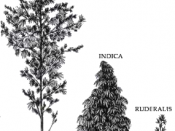Everyone has played on a tree at some point in their lives. Some have climbed them, or picked apples from them, or even just enjoyed the shade that they created. However, trees are becoming more and more scarce each year. According to the World Resource Institute only about 1% of our old growth forests remain within the United States. Loggers are clear-cutting forests in the Pacific Northwest and Virginia at an alarming rate for the production of paper products, timber and other assorted goods. Everything from plates, cups, towels, bank sleeves, and junk mail, waste needless amounts of tree pulp each year. The solution to this problem is the Legalization of Industrial Hemp as a cash crop for the production of paper products and goods, as well as material and oil based products. It is cheaper, cleaner, and safer than wood for our environment.
Industrial hemp's cultivation began in China around 2800 BC and was grown by many different people throughout the years.
Industrial Hemp is not a drug crop! The international standard is that hemp of Cannabis with less than 1% THC is not marijuana. Hemp is a close relative of marijuana, however, it has nearly none of the intoxicating effects of its cousin plant. Although industrial hemp does include trace amounts of THC, which is the mind altering chemical in marijuana, the levels are so low that one would have to smoke a joint roughly the size of a large telephone pole to feel any effects from it at all.
Although Industrial hemp was not a drug crop, it was lumped in with the Marijuana Tax Act and made illegal in 1937. However, because the Japanese invasion of the Philippine Islands during World War II put a stop to U.S. importation on Manila hemp, which was used for...


